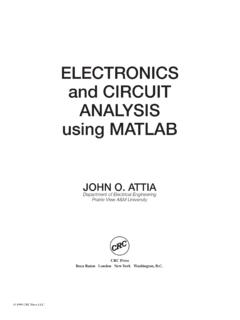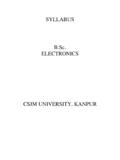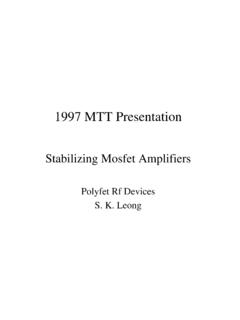Transcription of Common Mode and Differential Mode Noise Filtering
1 Common Mode and Differential Mode Noise Filtering Summary This application note gives a practical explanation of Differential mode and Common mode Noise along with the traditional Filtering approaches. In addition, an alternative method of Filtering is shown using X2Y components. Introduction In an ideal circuit, the signal from the source and load would require no Filtering . Figure 1 represents the ideal circuit's current path. The signal current, IS, flows on the positive conductor and signal's return current, Ir, flows on the negative conductor.
2 The relationship between the current on the two conductors is Is = -Ir. Is and Ir have the same magnitude, but different polarity. Figure 1. The desired circuit's current path. Differential Noise current that flows in the same directions as Is and Ir is called Differential Mode Noise mode Noise or Id, see Figure 2. The total current on the positive conductor is It_pos Current = Is + Id. Conversely, the total current on the negative conductor is It_neg = Ir +. Id. The relationship between It_pos and It_neg follows the same relationship, It_pos =.
3 -It_neg. The relationship between the current on the two conductors is Is = -Ir. Is and Ir have the same magnitude, but different polarity. Figure 2. The effects of Differential mode current in a circuit. DISCLAIMER: Information and suggestions furnished in this document by X2Y Attenuators, LLC are believed to be reliable and accurate. X2Y Attenuators, LLC. assumes no responsibility for its use, nor for any infringements of patents or other rights of third parties which may result from its' use. X2Y is a registered trademark. All other brand or product names mentioned in this document are trademark or registered trademarks of their respective holders.
4 These notes are subject to change without notice. Copyright X2Y Attenuators, LLC all rights reserved. Note# 2001, , 4/20/05 Page 1 of 10. Common Mode and Differential Mode Noise Filtering To attenuate Differential mode current in a circuit, a standard capacitor is used in an x-cap configuration, Figure 3. The value of the capacitor is chosen by matching the frequency of Id with the self-resonant frequency of the capacitor. At self-resonant frequency, the capacitor is at minimum impedance and provides an alternative return path to the source.
5 By Filtering out Id, the load receives only the desired signal generated by the source. Figure 3. x-cap configuration to minimize Differential mode current. Common Mode Noise current that flows in the same directions on both the positive and negative Noise Current conductors, as shown in Figure 4, is called Common mode Noise or Ic. The total current on the positive conductor is It_pos = Is + Ic. Conversely, the total current on the negative conductor is It_neg = Ir Ic. The relationship between It_pos and It_neg is no longer an equal magnitude with different polarities.
6 The circuit has become unbalanced; the source and load impedance are no longer equivalent with respect to Figure 4. The effects of Common mode current in a circuit. Note It_neg and It_pos do not have the same magnitude. One approach to attenuate Common mode current in a circuit is to use two standard capacitors in a y-cap configuration, Figure 5. Once again, the value of the capacitor is chosen by matching the frequency of Ic with the self-resonant frequency of the capacitor. Note# 2001, , 4/20/05 Page 2 of 10. Common Mode and Differential Mode Noise Filtering Figure 5.
7 Y-cap configuration to reduce Common mode Noise current. Special care must be taken to ensure that the capacitors are as tightly matched as possible. For example, the goal of the y-cap configuration is to filter out Ic and match the magnitudes of Is and Ir. If two capacitors are used that have a capacitance tolerance of 10%, a 20% discrepancy can exist in the amount of attenuation performed between the two conductors. A second approach to attenuate Common mode current in a circuit is to use feedthrough capacitors, see Figure 6. Feedthrough capacitors are able to work at higher frequencies and are more broadband than standard capacitors.
8 The disadvantage of feedthrough capacitors are higher cost and added impedance to the circuit of to ohms. In low voltage applications this could be an important consideration. Figure 6. Common mode Filtering using feedthrough capacitors. A third approach to attenuate Common mode current on a single conductor is to use an inductor, see Figure 7. An inductor in series acts like a short at DC and low frequencies. At high frequencies an inductor acts like an open. The voltage across an inductor is related to current by the rate of change in current.
9 Di V = L. dt Note# 2001, , 4/20/05 Page 3 of 10. Common Mode and Differential Mode Noise Filtering When current flows through the inductor magnetic flux is created. If the change in current is from a positive value, I+, to a negative value, I-, then the magnetic field will collapse and form magnetic flux in the opposite direction (use right-hand rule). At high frequencies the magnetic field cannot form because the rate of current change is too fast. Figure 7. Common mode Filtering using inductors . A fourth approach to attenuate Common mode current is to use a Common mode choke, see Figure 8.
10 Common mode chokes works like an inductor with an added feature. The Common mode current creates a flux. Since the flux created by each conductor is in the same direction it adds. This field causes a large impedance thus choking the throughput of the Common mode current on the conductors2. IS and IR are Differential signals and the mutual inductance of each cancels with the inductance of the choke resulting in IS and IR passing through the choke onto the load. Figure 8. Common mode Filtering using a Common mode choke. The fifth type of filter uses ferrite material that provides high impedance at the frequencies of the unwanted Noise .









